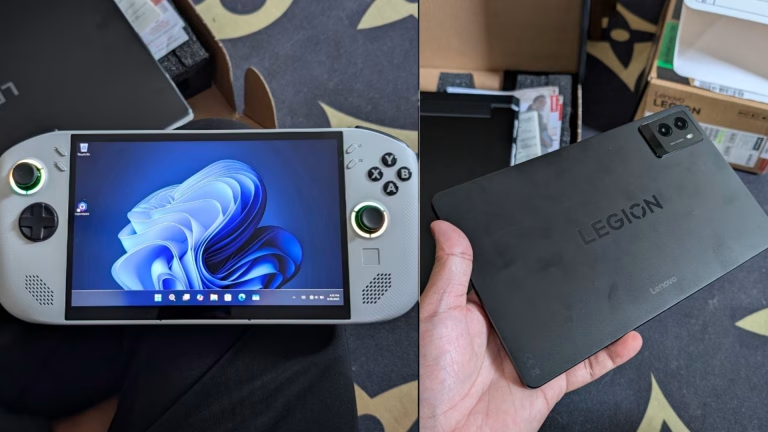
When I was approached by Lenovo to check out their new Lenovo Legion Pro 7i a couple of weeks ago, I couldn’t help but wonder what the laptop was capable of. Sure, we’ve heard of hundreds—thousands, even—of gaming laptop models, so what more can one more do for this year, no?
So I decided to give it a try. If you came here from the Lenovo Legion Go S article, then welcome back! Let’s take a look at Lenovo’s gaming laptop now. But if you just happen to encounter this one first, then by all means feel free to continue reading to see my thoughts and verdict on this heck-of-a-beast gaming laptop.
Specs
As always, I will list the specifications right here before I get further into my reviews on the Lenovo Legion Pro 7i. Feel free to read the details below for your research or comparison purposes.
| Component | Specification |
| Processor | Intel Core Ultra 9 275HX (Arrow Lake HX), 24-core (8P+16E), up to 5.4 GHz |
| GPU | Nvidia GeForce RTX 5070 Ti / 5080 / 5090 Laptop GPU, up to 24GB VRAM |
| RAM | 32GB or 64GB DDR5-6400 (2x SO-DIMM), upgradeable |
| Storage | 1TB–2TB SSD (PCIe 5.0 primary + PCIe 4.0 secondary, max 8TB user config) |
| Display | 16-inch QHD+ (2560×1600) OLED, 240Hz, 1ms, 500 nits, 100% DCI-P3 |
| Cooling System | Tri-fan, vapor chamber, AI-tuned, PTM thermal interface |
| Battery | 99.9Wh, 400W adapter, USB-C charging up to 140W |
| Connectivity | WiFi 7, Bluetooth 5.4, 2.5G LAN |
| Ports | HDMI 2.1, Thunderbolt 4, USB-C, USB-A, RJ45, audio jack, eShutter |
| Build Quality | All-metal, Eclipse Black, RGB accents, 2.65–2.72kg |
| Unique Features | Per-key RGB keyboard, OLED, GSync, AI Engine+, Legion Space, 5MP camera |
| Pricing | $2,849–$4,300+ USD (varies by GPU and RAM); ~RM13,999+ in Malaysia |
| Availability | US/EU markets July–September 2025; Malaysia from May/September 2025 |
With the technical part out of the way, now we’re going to delve deeper into what it REALLY feels like when you use the laptop for the very first time.
First Impression: It Is HEAVY.

If you’ve been carrying a gaming laptop around whenever you travel for work or just anywhere, then you’ll know that gaming laptops are never light. I’m used to carrying my HP Omen 15 2020 model, which is roughly around 2.5 kg or so (that’s about 5.5 lbs). So, to me, I’m used to it.
But this laptop—this Lenovo Legion Pro 7i—weighs almost 3 kg (about 6 lbs).
It’s like carrying a mini dumbbell in your bag. And that’s not accounting for the charging brick that comes with the laptop. It is no regular gaming laptop power brick; it is a HEFTY power brick that is about the same size as the brick you see for construction.

So, with the power brick, combined with the laptop in your bag, you’re going to have a field day carrying them around. By the end of the month of using it, you’d probably have one massive shoulder.
In all seriousness, it’s okay to carry them around, but you will start to feel shoulder fatigue after lugging the bag for longer than 10 minutes or so. And this is coming from a person who’s been carrying a gaming laptop in his bag every day for years.
The Legion Pro 7i Gen 10 is constructed with an all-metal chassis in Eclipse Black, blending durability, premium feel, and gamer aesthetics. The external finish is sandblasted aluminium, minimal flex on palm rest and lid, and a matte black finish that does tend to show fingerprints. The iconic Legion RGB logo on the lid, RGB lightbars, and RGB-accented power button deliver a modern yet restrained gamer aesthetic. RGB elements are controlled through Lenovo’s new Spectrum or Space utility (less mature than past Vantage software), allowing per-zone or per-key customisation, albeit with less granularity than some competitors.
Ergonomically, the 150-degree hinge is sturdy and smooth, giving wide versatility for various setups (though not 180°, as in previous generations). The footprint is larger than last year’s model, a trade-off for stronger thermals and more advanced hardware. To me, the design screams functionality, aesthetics, and robust build, which is something I don’t really mind at all.
The Main Powerhouse: Intel’s Arrow Lake-HX platform

Now, what really makes this laptop a beast is, apart from the NVIDIA graphics card, the latest powerful processor it has inside.
The Lenovo Legion Pro 7i 2025 is powered by Intel’s Arrow Lake-HX platform, specifically the top-tier Core Ultra 9 275HX. This processor features a hybrid architecture with 24 cores, split into 8 high-performance P-cores and 16 energy-efficient E-cores, supporting a maximum of 24 concurrent threads. With turbo frequencies reaching up to 5.4 GHz on P-cores, the 275HX has been empirically benchmarked as around 25–30% faster than the previous generation i9-14900HX when sustaining high-load scenarios—a crucial gain for gaming at high frame rates, professional rendering, and heavy multitasking.
In other words, if you need to run OBS, Twitch (or nowadays, TikTok live), and record your gameplay at the same time, this laptop can easily manage it. I didn’t manage to try streaming (mainly because I don’t have Twitch), but I did record some gameplay with my friends without any issues.

Lenovo and Intel really push the boundaries of your gaming and streaming this time with Intel processors and the dedicated Lenovo AI Engine+ powered by the LA AI Core. That way, I believe we can enjoy reduced in-game load times with DDR5 support.
Anyway, the Geekbench 6 scores in the 3,000+ range for single-core and over 21,000 for multi-core, situating it near the top of the contemporary mobile CPU spectrum. The sustained power delivery peaks roughly at ~170W in demanding performance modes. When it comes to the Lenovo AI Engine+, the Advanced AI and NPU integration enable more efficient creative workflows by accelerating AI-powered software, such as upscaling in video editors or runtime resource management for gaming.
These processing strengths translate into elite performance, whether the context is compiling code, live streaming with simultaneous game rendering, or handling multi-layered creative projects.

Notably, all variants of the Legion Pro 7i, regardless of GPU choice, share this flagship processor, which is something I genuinely applaud Lenovo for. The presence of built-in Intel Arc graphics within the CPU also enables better hybrid graphics switching and enhanced battery life for lighter user workloads, in conjunction with NVIDIA Advanced Optimus and the included MUX switch.
Let’s Talk about The GPU.

Lenovo Legion Pro 7i 2025 adopts the latest NVIDIA RTX 50 series (Blackwell) laptop GPUs. For this series, we have options including the RTX 5070 Ti (12GB GDDR7, 140W), RTX 5080 (16GB GDDR7, up to 175W TGP), and the premier RTX 5090 variant sporting 24GB VRAM. These GPUs also incorporate fifth-generation Tensor Cores for DLSS 4 (the fourth-generation RT Cores for real-time ray tracing, Frame Generation, and Nvidia Reflex 2 technology for latency minimisation), critical to competitive gaming.
What stands out is that these claims are not just theoretical: practical reviews find the RTX 5080 delivering 10–20% higher performance than the last-gen RTX 4080 at similar power, and the RTX 5090 raising the bar even further for AAA gaming and workstation-grade rendering.
On the gaming front, the RTX 5080 configuration enables QHD+ native resolution gaming at ultra settings with 60–145 FPS in a suite of modern AAA games, depending on genre and optimisation. Doom The Dark Ages, for example, ran at up to 145fps QHD+ and Cyberpunk 2077 at over 70fps 4K with DLSS 4 enabled.
The GSync and Advanced Optimus features ensure visually smooth gameplay, and the MUX switch provides full performance potential when the discrete GPU is needed.
The precise implementation of TGP (Total Graphics Power), as high as 175W for the RTX 5080 and RTX 5090, is sustained by the upgraded thermal system, enabling these GPUs to run close to their desktop-class clocks even under load. That is also practically the reason why the power brick is as big as it is. It was designed to run heavy tasks for something more than just gaming in mind. So if you’re looking for performance, this laptop can handle practically anything you can throw at it.
RAM Configurations

On the memory front, the Legion Pro 7i ships with a minimum of 32GB DDR5-6400 RAM in dual-channel configuration, with certain market and custom options boosting this to a maximum of 64GB (2x32GB SO-DIMMs). For general gaming, this configuration alone is already overkill, but if you’re doing something like 3D rendering, multi-tabbed browsing, and other software workloads, it definitely suits the power it offers.
The DDR5 SO-DIMM slots are easily accessible, so if you want to upgrade, you can do so without voiding the warranty.
For professionals and digital artists who probably run several heavyweight applications (e.g., Adobe Creative Cloud, Unreal Engine), the ability to configure to 64GB can be enticing to them as well.
Storage Options

Lenovo equips the Legion Pro 7i with extraordinarily fast storage solutions built around the latest PCIe standards. The primary storage is a PCIe Gen5 M.2 2280 SSD (typically shipping as a 1TB Samsung drive in most SKUs), with a secondary slot supporting PCIe Gen4 M.2 SSDs. Again, this laptop boasts seamless upgrades as users can install a second drive or replace original drives without voiding their warranty.
There is no 2.5″ SATA bay, however. That way, Lenovo can commit to its slim, high-performance philosophy. The use of top-tier SSDs ensures minimal game and workstation asset load times and greatly reduces hitching in open-world games or high-res video editing.
Display Details

The 2025 Legion Pro 7i adopts a 16-inch QHD+ (2560×1600, 16:10 aspect ratio) OLED panel, which is a first for the series. This screen features a 240Hz refresh rate and 1ms response time, accompanied by G-Sync for smooth, tear-free visuals. The brightness is rated at 500 nits in SDR, and the display covers 100% of the DCI-P3 colour space, with actual colour tests frequently exceeding 95% Adobe RGB coverage, making it a serious panel for creators as well as gamers.
Contrast is a stunning 1,000,000:1, enabled by OLED’s per-pixel illumination, and VESA TrueBlack 1000 rating stands as a nod to genuine HDR capability. The display’s deep blacks, punchy colours, and clarity are definitely something to praise for. There was also no visible graininess because of the non-touch implementation and a high PWM frequency that minimises OLED flicker-related eye strain.
As for the response time and refresh interpolation, I believe competitive gamers are able to enjoy ‘overkill’ levels of smoothness, while adaptive sync options ensure fluid rendering regardless of frame rate spikes or dips. Anti-burn-in technology is included, so you won’t have to worry about long gaming hours on end.
Cooling System

Lenovo’s ColdFront cooling system receives its most substantial upgrade to date with the Gen 10 Legion Pro 7i. It combines a tri-fan setup, a large vapour chamber, and heat pipes, with phase change thermal material (PTM) applied to both CPU and GPU dies. This configuration enables up to 250W sustained cross-load power (enough for simultaneous CPU+GPU boosting), which is essential to leverage the potential of the Core Ultra 9 275HX and RTX 50 GPUs. Acoustic AI and smart fan mapping enable real-time adjustment of fan speed to minimise noise while maximising cooling effectiveness.
The system’s practical benefits are evident under load: fan noise is measured at ~45–50dBA in ‘Performance’ or ‘Custom’ modes, but Lenovo’s ‘Quiet’ mode delivers compelling gaming performance at sub-35dBA noise levels. For something that screams power, it sure is an impressive feat. Temperatures during heavy multitasking or gaming hover around 75–85°C for the CPU and high 70s for the GPU, with keyboard and palmrest areas thermally isolated to prevent user discomfort.

The cooling system’s performance is, by consensus, among the best in the gaming laptop category, and is one of the enablers for desktop-class gaming power in a mobile form factor.
Battery Life and Power
With the 99.9Wh Li-Po battery, Lenovo claims up to 7 hours of light productivity usage, which is supported by some synthetic video playback benchmarks (notably PCMag’s 7h18min video test).
As for real-usage scenarios, this laptop averages between 3–6.5 hours, with up to 4–5 hours for office tasks/web, and ~1.5 hours for gaming at performance settings.
What I do love about this laptop is that it supports USB-C charging (up to 140W), which is useful for fast top-ups and if you forget or couldn’t bother to bring the heavy power brick everywhere you go. But of course, if you want the maximum performance, you need to use the included 400W dual-piece GAN power adapter.
Lenovo’s Super Rapid Charge technology allows the battery to hit 70% in 30 minutes, minimising downtime in mobile workflows.
Overall, the battery life is competitive for a laptop this powerful and with such a bright OLED display. If you’re seeking the longest unplugged use, you are advised to use hybrid graphics (Optimus on) and limit display brightness and refresh rate. Full performance (including overclocking and maximised power delivery) is only available when plugged in via the 400W adapter.
Connectivity Options


This laptop still boasts a huge number of ports, thankfully. The left edge houses DC-In, HDMI 2.1, one USB-C Thunderbolt 4 port, another USB-C with Power Delivery, and a fast USB-A port. The right edge has two USB-A ports, another RJ45 jack, a 3.5mm audio combo jack, and a physical eShutter button for the webcam. I still wish the audio jack would be placed on the left side of the laptop, but it didn’t bother me much during prolonged use of the laptop.
If there is anything missing, it is the traditional rear-port array and the SD card reader. Some will miss these omissions, and understandably so. But the laptop does offer other ports for productivity purposes.
Pricing and Availability

Pricing for the Legion Pro 7i Gen 10 is configuration-dependent. In Malaysia, starting retail is RM13,999 (now at a discounted price of RM10,627.55) and up, with frequent promotions and business/education discounts available. Regional differences may affect included accessories and warranties, so buyers are encouraged to check local Lenovo sites and major retailers like Amazon, B&H, and authorised resellers for specific deals.
Availability began in March 2025 for the US/EU, rolling out to Asia and other global markets by September 2025. Delivery times have stabilised to 1-2 weeks in most regions, and global coverage is established for warranty support. The laptop is sold as ‘Legion Pro 7i’ (Intel) in most English-language markets and simply ‘Legion Pro 7’ in Europe.
My Final Take on Lenovo Legion Pro 7i

For starters, the OLED display is genuinely good. It garners near-universal acclaim for its deep blacks, high dynamic range, and esports-grade refresh rates. Game performance is among the best in the portable segment, and AI-driven optimisation features deliver real, if incremental, benefits in FPS and battery efficiency, especially in mixed workload scenarios.
As for the build quality, the keyboard is definitely top tier — I had no issues typing and gaming on the laptop, and it was very comfortable to rest my fingers on. The weight of the laptop, however, together with the larger footprint, can somewhat be a compromise, but that is the trade-off for performance.
As for the battery life, it is above average for the category, but not exactly a selling point compared to ultraportables or non-OLED laptops. Acoustics (fan noise under load) are well-controlled, though performance does drop somewhat in ‘Quiet’ modes.
All in all, the Lenovo Legion Pro 7i Gen 10 (2025) integrates the fastest mobile CPU and GPU technology currently available. The transition to a high-refresh OLED panel immediately elevates both gaming and creative capabilities, while AI-driven features reflect Lenovo’s thorough response to evolving user demands in the top gaming segment.
Pricing, of course, remains ambitious, as is typical in this class, but you get what you pay for. The value is, once you have it in your hand, definitely worth every penny with delivered technology and upgradability. To me, the Legion Pro 7i Gen 10 is an elite desktop replacement laptop that will satisfy power users in both gaming and content creation arenas and can serve equally well in competitive contexts or creator studios.
But hey, don’t miss out on this! Check out the latest Lenovo Legion Pro 7i on their official website today and get that gaming laptop you deserve!
Thank you for reading! As always, feel free to click here to read more from us!







